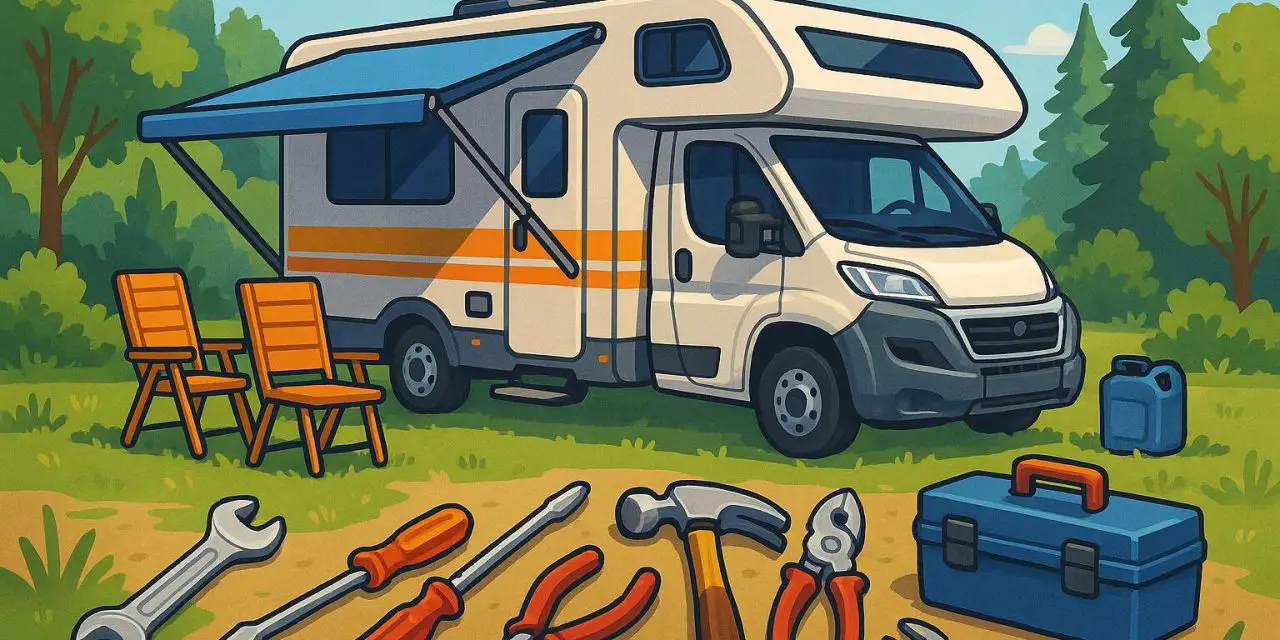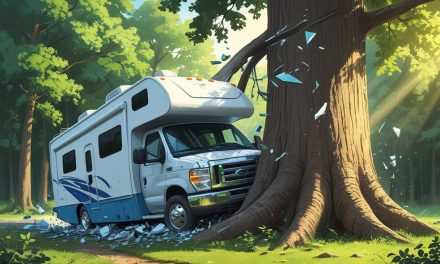Would you like to save this article?
Life on the road in your recreational vehicle should be about freedom, adventure, and making memories – not constantly dealing with annoying problems that could easily be prevented. Whether you’re a weekend warrior or a full-time RVer, these brilliant zero-cost solutions will transform your camping experience from stressful to spectacular.
With over 11.2 million American households now owning RVs, smart campers have discovered ingenious ways to solve common problems using items you probably already have in your rig. These marriage-saving hacks have been tested by real RVers who understand that sometimes the simplest solutions are the most effective.
Get ready to become the hero of your next camping trip with these game-changing tips that won’t cost you a single penny!
1. The Magical Zip Tie Screw Fix
When your RV screws work loose (and they will work loose), you don’t need to panic or make an expensive trip to the hardware store. Your RV is basically a house on wheels that’s constantly rattling and shaking, which means screws naturally loosen over time, especially in the thinner paneling found in most recreational vehicles.
Here’s the genius solution: Grab a zip tie from your supply bin and insert it into the stripped-out screw hole about as far as the screw will penetrate. The zip tie effectively reduces the hole size and gives your screw something new to bite against. Simply thread your screw through the zip tie, cut off the excess, and tighten everything down.
| Problem | Traditional Solution | Zero-Cost Hack |
|---|---|---|
| Stripped screw holes | Buy expanding anchors ($5-10) | Use zip ties (free from supply bin) |
| Loose screws in thin panels | Replace entire panel section | Insert zip tie for instant grip |
| Emergency roadside repairs | Wait for hardware store | Fix immediately with supplies on hand |
The RV industry ships over 333,000 units annually, and virtually every one of them will experience this common problem. You could spend money on expanding anchors (which are great for permanent fixes), but when you’re boondocking in the middle of nowhere, a simple zip tie becomes your best friend.
You might look like a DIY genius to your camping neighbors, but let’s be honest – you’re just using whatever works! Your spouse will be impressed that you solved the problem without spending three hours at the hardware store or declaring the entire trip ruined.
2. The Grease Bag Trick That Stops Marital Disputes
Keeping grease on your hitch ball is absolutely essential for smooth towing and preventing premature wear on your expensive coupler. However, constantly getting black grease on your clothes has probably caused more camping arguments than burnt marshmallows and forgotten camping chairs combined.
The brilliant solution: Take a quart-size sandwich bag (the ones with plastic zippers work best) and put your preferred grease on the hitch ball. Place the bag over the ball and zip it closed. This keeps grease off your clothes while protecting the grease from rain, dirt, and other contaminants when you’re not hooked up.
With RV sales totaling over $20 billion in retail value, manufacturers are constantly improving coupler technology, but they’re still made of metal that wears against metal. A hitch ball costs around $15-30 to replace, while a welded trailer coupler can cost $200-500 to remove and replace – plus labor costs that’ll make your wallet cry.
You’ll drive around looking slightly ridiculous with a sandwich bag on your hitch ball, but it beats explaining to your spouse why you need to buy new camping pants for the third time this season. Plus, it’s an excellent conversation starter at campgrounds – nothing says “experienced RVer” like creative problem-solving!
3. Lightweight Closet Mirrors That Actually Work
Finding the perfect mirror solution for RV closets seems impossible when you’re dealing with weight restrictions, thin panel boards, and the constant need to avoid drilling unnecessary holes. Traditional glass mirrors require frames and mounting hardware that simply don’t work well in most RVs.
The unexpected winner: Cheap acrylic mirror kits that mount with double-sided tape. These flexible, extremely lightweight mirrors cost around eight dollars and can be installed anywhere without drilling a single hole. They come in multiple sizes and work surprisingly well for such an inexpensive solution.
According to RV Industry Association data, the average RV owner uses their vehicle about 20 days per year, but during those days, functional storage and mirror space becomes incredibly important for maintaining relationships and sanity. These mirrors solve the problem without adding significant weight to your rig.
| Traditional Mirrors | Acrylic Mirror Hack |
|---|---|
| Heavy glass construction | Ultra-lightweight acrylic |
| Requires screws and frames | Mounts with tape only |
| $30-80 per mirror | $8 for complete kit |
| Risk of shattering | Flexible and nearly unbreakable |
You might be skeptical about eight-dollar mirrors from Amazon, but sometimes the cheapest solution is actually the smartest one. Your spouse will appreciate having functional mirror space without you turning into a weekend warrior with a power drill.
4. The Seven-Pin Connector Testing Trick
Testing your RV lights without a truck sounds impossible, but experienced RVers know a simple workaround that can save you from discovering burned-out bulbs after you’ve already set up camp. This hack works on towable RVs with standard seven-pin connectors and can be a real lifesaver during solo trips.
The ingenious method: Use a 15-amp fuse to jump between terminals on your seven-pin connector. Connect terminal six (12-volt positive from coach battery) to terminal one (running lights input) to test your running lights. You can also test turn signals, brake lights, and backup cameras by jumping power to the appropriate pins.
With over 280 RV manufacturers producing hundreds of different models, electrical problems are unfortunately common. The RV industry generates $140 billion in economic impact annually, but that doesn’t mean your lights won’t fail at the worst possible moment.
Important safety notes:
- Never jump power to the ground terminal (position 3)
- Avoid the brake controller terminal (position 4)
- Use properly rated fuses for each circuit
- Don’t walk away while testing – remove jumpers immediately after testing
You’ll feel like an electrical wizard performing this trick, but remember that knowledge is power – literally in this case. Your camping partner will be amazed when you diagnose light problems before they become roadside emergencies.
5. The Rubber Glove Caulk Tube Sealer
Sealing caulk tubes properly is one of those annoying little problems that every RVer faces multiple times per season. You can buy specialized caps and plugs, or you can use this brilliant zero-cost solution that works just as well (and sometimes better).
The simple hack: When you’re done caulking and wearing rubber gloves, cut off one finger of the glove and place it over the caulk tube tip. Secure it tightly with a zip tie around the base. Nitrile rubber gloves are non-porous, so when properly secured, they prevent air from entering the tube and keep your caulk fresh for future use.
RV maintenance is crucial when you consider that the average RV costs between $14,000 and $750,000 depending on type and luxury level. Proper sealing prevents water damage that can cost thousands to repair, making this simple hack potentially worth hundreds of dollars in prevented damage.
You might feel silly cutting up perfectly good gloves, but you’ll feel even sillier when you have to buy a new tube of expensive RV sealant because the old one dried up. Your practical spouse will appreciate your resourcefulness – and your budget will too.
6. Tankless Water Heater Temperature Mastery
Tankless water heaters are becoming standard in modern RVs, but many owners struggle to understand how they work differently from traditional tank systems. This knowledge gap leads to cold showers, wasted propane, and frustrated family members.
The game-changing approach: Set your tankless water heater to your desired shower temperature and use only the hot water faucet when showering. Unlike tank heaters that provide consistent temperature regardless of flow rate, tankless units require specific flow rates (typically 0.3 to 0.7 gallons per minute) to ignite properly.
Industry statistics show that RV shipments increased 6% in 2024, with many new units featuring tankless systems. Understanding proper operation saves both propane costs and relationship harmony during those crucial morning shower routines.
| Tank Water Heater | Tankless Water Heater |
|---|---|
| Constant temperature regardless of flow | Requires minimum flow rate to ignite |
| Mix hot and cold at faucet | Set temperature at unit, use hot faucet only |
| Energy used continuously | Energy used only when needed |
| Limited hot water supply | Unlimited hot water (with proper flow) |
You might need to retrain your shower habits after years of mixing hot and cold water, but you’ll quickly appreciate unlimited hot water and lower propane bills. Your camping companions will definitely notice when hot showers are consistently available instead of mysteriously disappearing mid-rinse.
7. EMS Security Solutions That Actually Work
Protecting your expensive electrical management system (EMS) from theft requires more than hope and good luck. With EMS units costing $300-600, they’re attractive targets for opportunistic thieves at campgrounds.
The evolved security method: Upgrade from basic bike locks to cinch locks that tighten around pedestals. Unlike regular cable locks that can slide over pedestal tops, cinch locks pull tight and won’t slide over breaker box doors, making theft much more difficult and time-consuming.
The RV industry supports nearly 680,000 jobs and generates massive economic activity, but that doesn’t prevent campground theft. While no lock stops determined thieves with bolt cutters, visible security measures deter opportunistic theft and force thieves to move on to easier targets.
Security comparison:
- Basic bike locks: Easy to slide over pedestals
- Cinch locks: Tighten securely, can’t slide over doors
- Hardwired EMS: Ultimate security inside RV (but requires installation)
You might feel paranoid locking up everything at “friendly” campgrounds, but you’ll feel much worse explaining to your insurance company how your expensive EMS walked away in the night. Your practical camping partner will appreciate your proactive approach to protecting your investment.
SOURCES
- RV Camping Hacks That Are EFFECTIVE & Cost NOTHING – YouTube Video
- RV Industry Association Reports & Trends
- Consumer Affairs RV Industry Statistics 2025
- RV Industry Economic Impact Study – $140 Billion Impact
- Mordor Intelligence North American RV Market Report
- Go RVing RV Owner Demographic Profile Study





